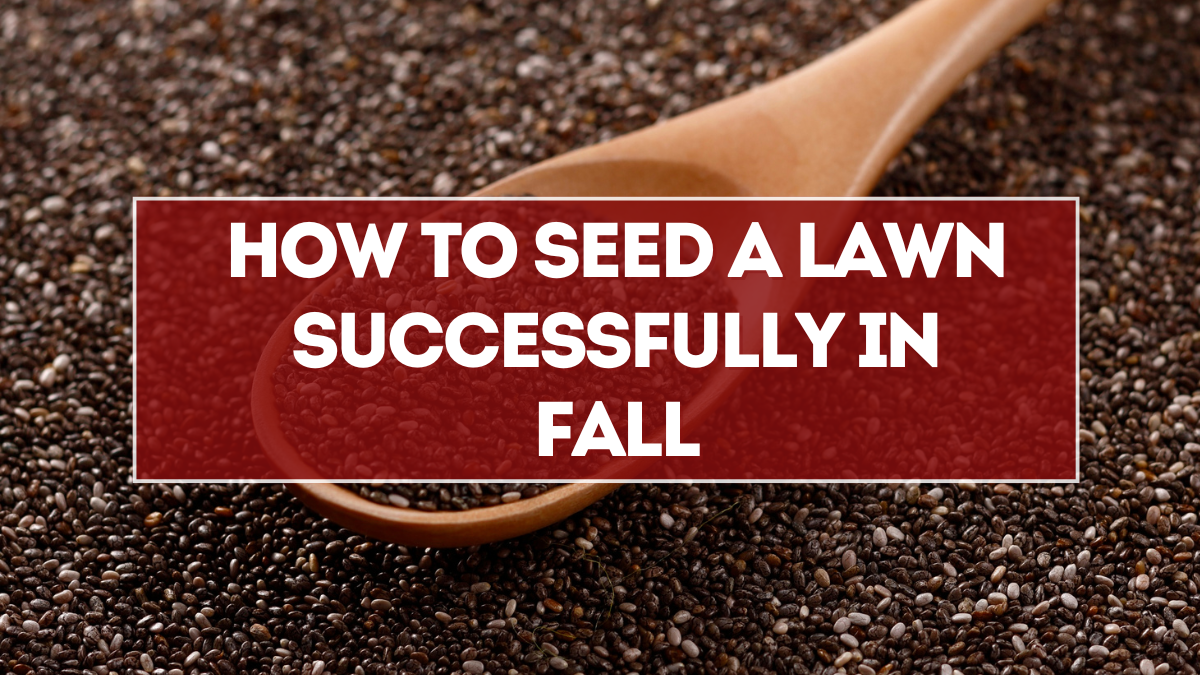Fall is one of the best times to seed or overseed a lawn. The cooler temperatures, frequent rainfall, and reduced weed competition create ideal conditions for grass seed germination. Whether you’re starting a brand-new lawn or thickening thin patches, knowing how to seed a lawn successfully in fall ensures your grass develops strong roots before winter.
This guide provides a step-by-step process and clear timeline covering everything from soil preparation and seed rate to topdressing, fertilization, and rolling. Follow these techniques and you’ll enjoy a lush, green lawn next spring.

Why Fall is the Best Season for Seeding
Many homeowners think spring is the ideal time for planting grass, but fall actually offers several advantages:
-
Cool soil temperatures (50–65°F / 10–18°C) promote quick germination.
-
Less weed competition, since crabgrass and summer weeds die back.
-
Consistent rainfall reduces the need for constant watering.
-
Strong root development before winter leads to healthier spring growth.
By seeding in fall, you give grass a head start, ensuring a denser, more resilient lawn.
Step 1: Soil Preparation
Healthy soil is the foundation of a successful lawn. Skipping soil prep is one of the most common mistakes.
-
Test the soil pH: Ideal range is 6.0–7.0. If it’s too acidic, add lime; if too alkaline, add sulfur.
-
Remove debris: Clear away rocks, sticks, and weeds.
-
Loosen compacted soil: Use a rake or tiller to break up the top 2–3 inches of soil. For larger lawns, consider core aeration to relieve compaction and improve root penetration.
-
Incorporate compost or topsoil: Adding organic matter improves drainage, nutrient retention, and microbial activity.
Good soil prep ensures the seeds contact soil directly, which is critical for germination.
Step 2: Choose the Right Seed
Not all grasses thrive in the same regions. Select seed blends suited to your climate and lawn goals.
-
Cool-season grasses: Kentucky bluegrass, fescue, ryegrass (best for northern regions).
-
Warm-season grasses: Bermuda, zoysia, centipede (better for southern regions but seeded in spring, not fall).
Look for certified seed mixes with high germination rates and minimal weed seed content. Avoid cheap seed bags, as they often contain fillers.
Step 3: Calculate the Seed Rate
Using too little seed leaves bare spots, while over-seeding leads to overcrowding. Follow recommended rates on seed packaging, but here are general guidelines:
-
New lawns: 6–8 pounds per 1,000 sq. ft. (ryegrass) or 2–3 pounds for Kentucky bluegrass.
-
Overseeding existing lawns: 3–5 pounds per 1,000 sq. ft.
Always weigh out your seed in advance to avoid uneven spreading.
Step 4: Spread the Seed Evenly
For even coverage:
-
Use a broadcast spreader for large lawns.
-
Use a hand spreader or spread by hand for small areas.
-
Apply half the seed in one direction, then the other half in a crisscross pattern to prevent stripes.
After spreading, lightly rake the soil so seeds are covered with about 1/8–1/4 inch of soil. Seeds left exposed on the surface may dry out or be eaten by birds.
Step 5: Apply Starter Fertilizer
Fertilizer is essential for young seedlings that need quick access to nutrients. Use a starter fertilizer high in phosphorus to promote root development.
-
Apply according to label instructions, usually around 1 pound of nitrogen per 1,000 sq. ft.
-
Avoid high-nitrogen fertilizers meant for established lawns, as they promote blade growth over root growth.
This feeding gives seedlings the best possible start.
Step 6: Topdressing for Protection
Covering newly seeded areas with a thin layer of compost, peat moss, or straw helps protect seeds and retain moisture.
-
Spread a light layer (no more than 1/4 inch) so seedlings can emerge easily.
-
Compost improves soil structure, while straw prevents erosion and bird damage.
-
Avoid hay, as it may contain weed seeds.
Topdressing prevents seeds from drying out and boosts germination rates.
Step 7: Watering Schedule
Watering correctly is critical for germination. Many lawns fail because seeds either dry out or sit in soggy soil.
-
Water lightly 2–3 times per day for the first 2 weeks to keep soil consistently moist.
-
As seedlings emerge, reduce frequency but increase depth of watering.
-
After 4–6 weeks, shift to deep watering once or twice a week.
Always water in the early morning to prevent evaporation and disease.
Step 8: Rolling or Pressing the Seed
After seeding and topdressing, gently roll the area with a lawn roller or walk over it with flat boards. This ensures seeds press firmly into the soil for better contact.
Do not compact the soil—just firm it enough to prevent seeds from blowing away.
Fall Seeding Timeline
Here’s a sample October seeding schedule for cool-season grasses:
-
Week 1: Prepare soil, aerate, and test pH.
-
Week 2: Spread seed, apply starter fertilizer, and topdress.
-
Week 3: Water frequently and watch for germination.
-
Week 4–5: Thin seedlings begin filling in—reduce watering gradually.
-
Week 6: Apply a light feeding if necessary, then prepare lawn for winter.
By following this timeline, your grass will have several weeks to establish before frost.
Common Mistakes to Avoid
-
Using the wrong seed blend for your climate.
-
Forgetting to rake seed into soil, leaving it exposed.
-
Applying too much fertilizer, which burns seedlings.
-
Overwatering, which encourages fungal diseases.
-
Waiting too late in fall—seeds need 6–8 weeks before the ground freezes.
Avoiding these errors ensures strong, healthy turf.
Benefits of Fall Seeding
Seeding in fall gives your lawn advantages that spring seeding cannot match:
-
Denser grass that resists weeds.
-
Deep root systems that withstand drought and pests.
-
A greener, healthier lawn in early spring without gaps.
With proper planning, you’ll notice a visible improvement by the time winter ends.
FAQs
When is the best time to seed a lawn in fall?
The ideal window is early to mid-October, when soil is warm but air temperatures are cool.
Do I need to fertilize after seeding?
Yes, a starter fertilizer high in phosphorus helps promote strong root growth.
Should I cover grass seed with soil?
Yes, a light covering of soil, compost, or peat moss improves germination and protects seeds.
How long does it take for grass seed to germinate in fall?
Most cool-season grasses germinate in 7–21 days, depending on soil temperature and moisture.
Is rolling necessary after seeding?
While not required, rolling improves seed-to-soil contact, which boosts germination rates.
Click here to know more.
